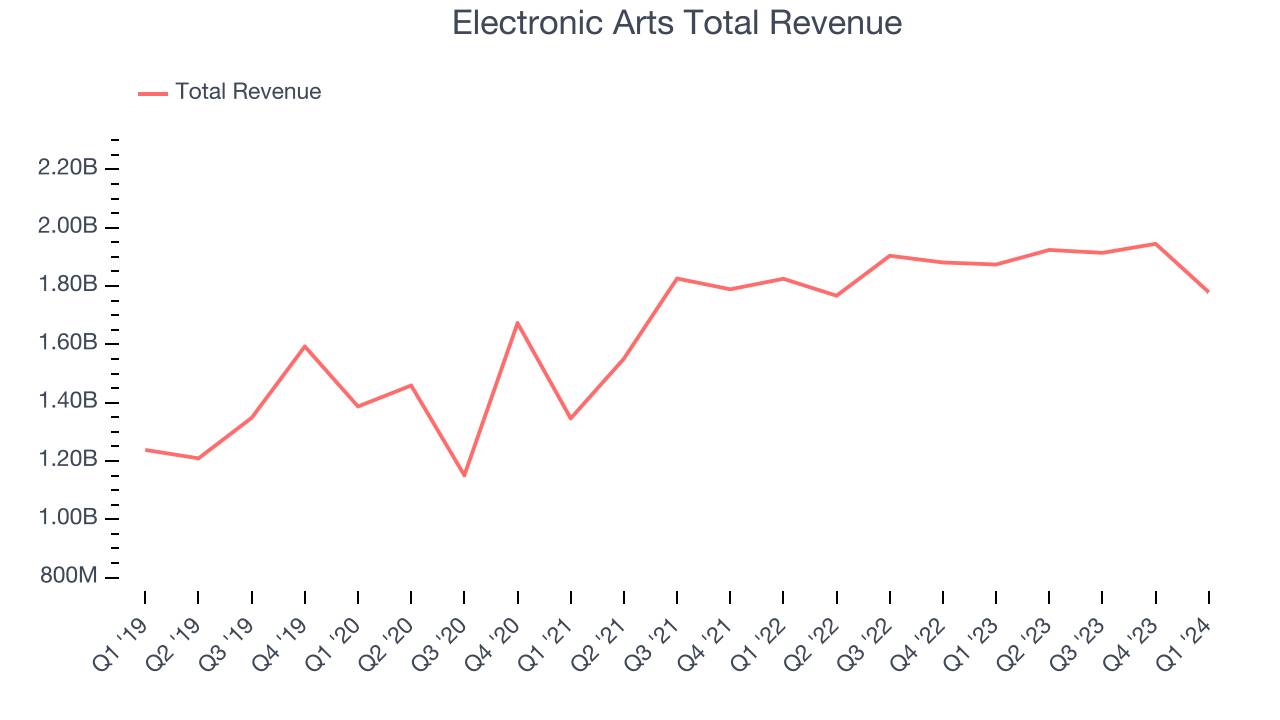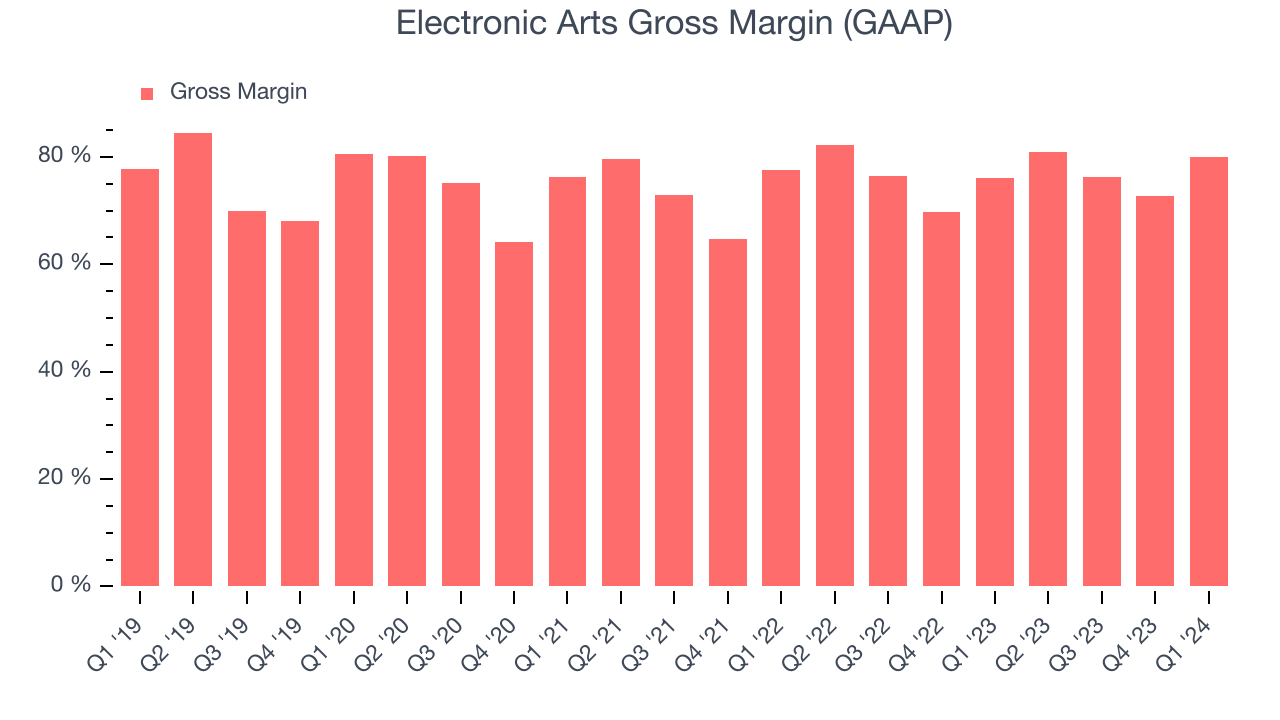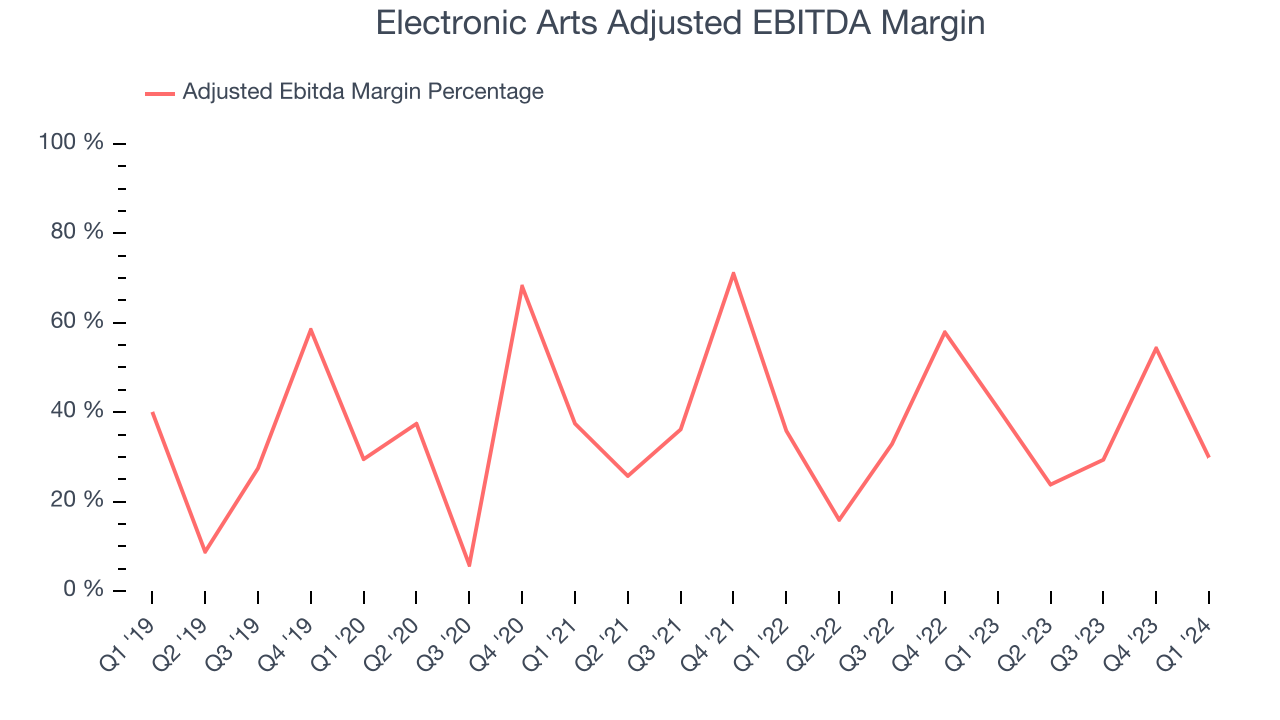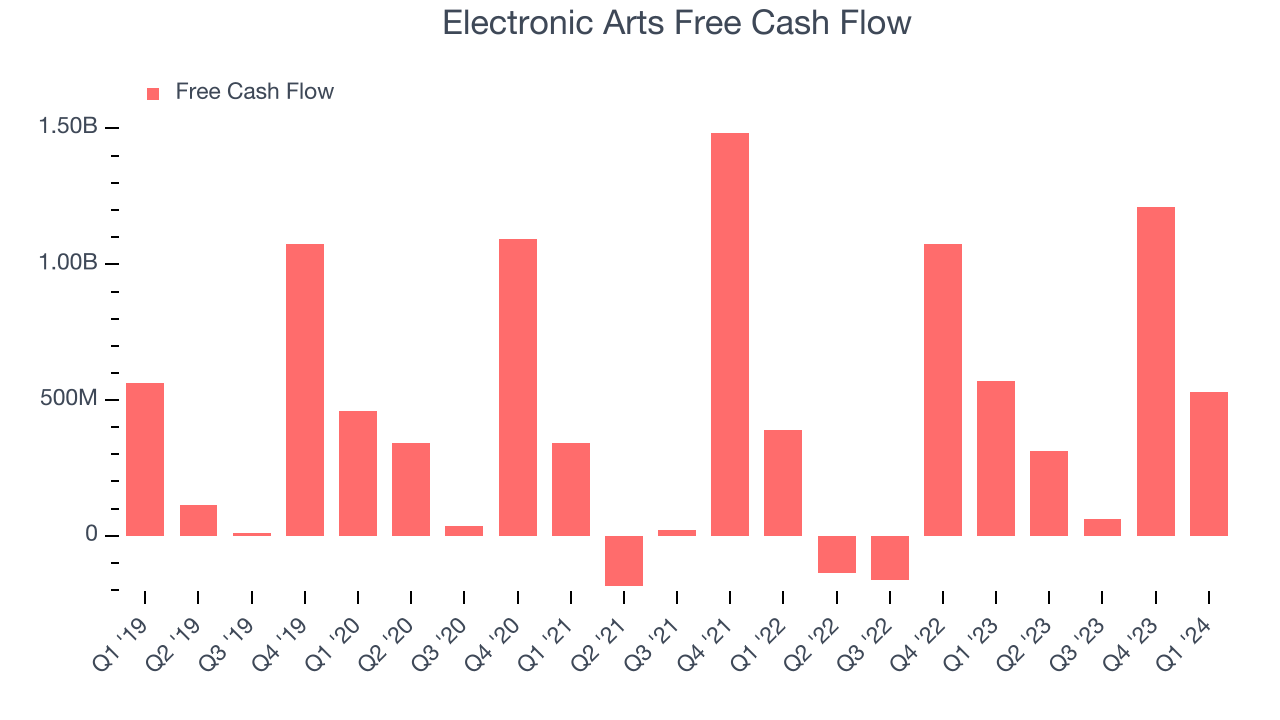Video game publisher Electronic Arts (NASDAQ:EA) reported results in line with analysts' expectations in Q1 CY2024, with revenue down 5.1% year on year to $1.78 billion. On the other hand, the company's full-year revenue guidance of $7.3 billion at the midpoint came in 6% below analysts' estimates. It made a GAAP profit of $0.67 per share, improving from its loss of $0.04 per share in the same quarter last year.
Electronic Arts (EA) Q1 CY2024 Highlights:
- Revenue: $1.78 billion vs analyst estimates of $1.77 billion (small beat)
- EPS: $0.67 vs analyst estimates of $0.59 (14.4% beat)
- Management's revenue guidance for the upcoming financial year 2025 is $7.3 billion at the midpoint, missing analyst estimates by 6% and implying -3.5% growth (vs 1.9% in FY2024)
- Gross Margin (GAAP): 79.9%, up from 76.1% in the same quarter last year
- Free Cash Flow of $529 million, down 56.4% from the previous quarter
- Market Capitalization: $34.91 billion
Best known for its Madden NFL and FIFA sports franchises, Electronic Arts (NASDAQ:EA) is one of the world’s largest video game publishers.
Electronic Arts develops video games for consoles, PCs, and mobile devices across diverse genres, such as sports, racing, first-person shooter, action, role-playing, and simulation. Electronic Arts monetizes in multiple ways: the sale of full premium games, free-to-play games with in-game purchases, and subscription-style content. It also sells in-game advertising and operates e-sports leagues which generate revenue through sponsorship and franchise sales.
Where Electronic Arts differentiates itself from rivals is through its collection of long-running dominant sports franchises such as FIFA, NHL, and Madden NFL, whose annual releases provide the company with annuity-like revenue streams. Those titles, along with its Star Wars games, are all licensed, though the company also has a long track record of releasing its own innovative new games that become genre-defining, such as The Sims/SimCity, Need for Speed, Apex Legends, Battlefield, and Plants vs. Zombies.
Video Gaming
Since videogames were invented in the 1970s, they have gradually taken more share of entertainment time. Ubiquitous mobile devices have powered a surge in “snackable” games that can be played on the go. Over time, games have developed more social engagement features where friends can play games together over the internet. The business models of games publishers have become less volatile due to digitization of distribution, in game monetization, and like Hollywood, an increasing dependence on surefire hit franchises. Covid driven lockdowns accelerated adoption and usage of videogames – a trend that has not slowed.
Electronic Arts competes with other large video game companies including Take Two (NASDAQ:TTWO), Roblox (NYSE:RBLX), and Nintendo (TSE:7974).
Sales Growth
Electronic Arts's revenue growth over the last three years has been unremarkable, averaging 11.8% annually. This quarter, Electronic Arts reported a year on year revenue decline of 5.1%, in line with analysts' estimates.

For the upcoming financial year, management expects revenue to be $7.3 billion at the midpoint, representing a 3.5% drop compared to the 1.9% growth in FY2024.
Pricing Power
A company's gross profit margin has a major impact on its ability to exert pricing power, develop new products, and invest in marketing. These factors may ultimately determine the winner in a competitive market, making it a critical metric to track for the long-term investor.
Electronic Arts's gross profit margin, which tells us how much money the company gets to keep after covering the base cost of its products and services, came in at 79.9% this quarter, up 3.8 percentage points year on year.
For gaming businesses like Electronic Arts, these aforementioned costs typically include royalties to sports leagues or celebrities featured in games, fees paid to Alphabet or Apple for games downloaded in their digital app stores, and data center and bandwidth expenses associated with delivering games over the internet. After paying for these expenses, Electronic Arts had $0.80 for every $1 in revenue to invest in marketing, talent, and the development of new products and services.

Electronic Arts's gross margins have been trending up over the last 12 months, averaging 77.4%. Its margins are some of the highest in the consumer internet sector, enabling it to fund large investments in product and marketing during periods of rapid growth to stay one step ahead of the competition.
User Acquisition Efficiency
Consumer internet businesses like Electronic Arts grow from a combination of product virality, paid advertisement, and incentives (unlike enterprise software products, which are often sold by dedicated sales teams).
Electronic Arts is extremely efficient at acquiring new users, spending only 17.5% of its gross profit on sales and marketing expenses over the last year. This efficiency indicates that it has a highly differentiated product offering and customer acquisition advantages from scale, giving Electronic Arts the freedom to invest its resources into new growth initiatives while maintaining optionality.
Profitability & Free Cash Flow
Investors frequently analyze operating income to understand a business's core profitability. Similar to operating income, adjusted EBITDA is the most common profitability metric for consumer internet companies because it removes various one-time or non-cash expenses, offering a more normalized view of a company's profit potential.
Electronic Arts reported EBITDA of $531 million this quarter, resulting in a 29.8% margin. Additionally, Electronic Arts has demonstrated extremely high profitability over the last four quarters, with average EBITDA margins of 34.5%.

If you've followed StockStory for a while, you know that we emphasize free cash flow. Why, you ask? We believe that in the end, cash is king, and you can't use accounting profits to pay the bills. Electronic Arts's free cash flow came in at $529 million in Q1, down 7.2% year on year.

Electronic Arts has generated $2.12 billion in free cash flow over the last 12 months, an eye-popping 28% of revenue. This robust FCF margin stems from its asset-lite business model, scale advantages, and strong competitive positioning, giving it the option to return capital to shareholders or reinvest in its business while maintaining a healthy cash balance.
Key Takeaways from Electronic Arts's Q1 Results
We struggled to find many strong positives in these results. Although this quarter's revenue and EPS beat, its full-year revenue and EPS guidance missed analysts' expectations. Forward projections move stocks more than current results, so this was a bad quarter for Electronic Arts because of its worse-than-expected outlook. The company is down 3.8% on the results and trades at $125.25 per share.
Is Now The Time?
Electronic Arts may have had a tough quarter, but investors should also consider its valuation and business qualities when assessing the investment opportunity.
There are several reasons why we think Electronic Arts is a great business. Although its revenue growth has been a little slower over the last three years, its growth over the next 12 months is expected to be higher. On top of that, its powerful free cash flow generation enables it to stay ahead of the competition through consistent reinvestment of profits, and its user acquisition efficiency is best in class.
At the moment, Electronic Arts trades at 12.7x next 12 months EV-to-EBITDA. Looking at the consumer internet landscape today, Electronic Arts's qualities stand out, and we like the stock at this price.
Wall Street analysts covering the company had a one-year price target of $152.12 per share right before these results (compared to the current share price of $125.25), implying they saw upside in buying Electronic Arts in the short term.
To get the best start with StockStory check out our most recent Stock picks, and then sign up to our earnings alerts by adding companies to your watchlist here. We typically have the quarterly earnings results analyzed within seconds of the data being released, and especially for the companies reporting pre-market, this often gives investors the chance to react to the results before the market has fully absorbed the information.
